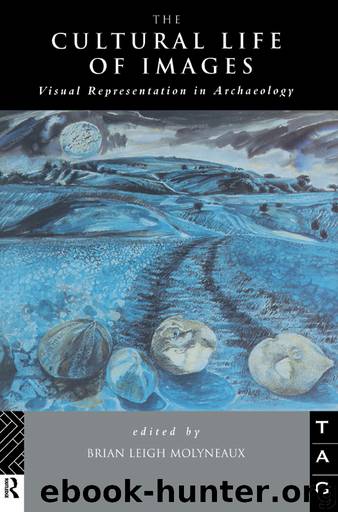The Cultural Life of Images by Molyneaux Brian Leigh

Author:Molyneaux, Brian Leigh [Molyneaux Brian Leign]
Language: eng
Format: epub
ISBN: 9781134546305
Publisher: Taylor and Francis
IMAGES OF OTHERS
The Greek’s image of himself, whether athlete, hero, or deity, is familiar to us all, as it is stamped on the art and history of Western Europe. As an example we may choose one of the recently discovered life-size bronze statues from the sea off Riace (Fig. 7.2) - naked and perfectly shaped. It was this chauvinistic self-image that was repeated over and over again, whether in archaic, Classical, or later form.
Figure 7.2 Bronze statue from Riace: Reggio, Museo Nazionale. c. 460-450BC (Photo: Museum).
Their view of the ‘other’, the non-Greeks, the barbarians, was obviously mediated through their own self-image and through this emphasis on the human form that is a hallmark of Greek visual imagery. The Greek image served as a foundation on which specific deviations were built.
Temples and treasuries were expensive constructions, usually commissioned by states, and the choice of their decoration often reflected the state’s immediate concerns. The sculptural scenes were not just decorative adjuncts or randomly chosen myths, there was a programme that reflected the interests of the commissioners.
Greeks, whether humans or deities, were shown in mythical, epic combats that spoke of recent struggles against Persians and that projected the superiority of the Greek forces (Hall 1989:68). In fifth-century Athens some of the major architectural constructions of the years after the Persian Wars (the Theseion, the Painted Colonnade, the Parthenon and its cult statue) were decorated with themes that made reference to those recent struggles by reference to legendary combats.
The Persians were cast in different roles, all deviations from the Greek standard: as hostile, uncivilized giants, whether warriors, cavemen, or monsters, that the Olympians had to overcome in order to establish their power (LIMC IV: s.v. Gigantes; Arafat 1990, Chapter 8); as hybrids such as the Centaurs who misbehaved in an inhuman fashion; as Amazons, the warlike women who rode horses and wielded the bow, the very antithesis of the masculine Greek warriors and a suitable counterpart for the ‘effeminate’ Persians (von Bothmer 1957; Tyrrell 1984; LIMC I: s.v. Amazones; Hall 1993:114-15; Henderson 1994); and as Trojans, that old enemy to the east, the rich and powerful Asiatic kingdom that had proved no match for the united vigour of the Greek heroes. As Hall (1989:5) says, ‘it was the fifth century which invented the notion of the barbarian as the universal anti-Greek against which Hellenic - especially Athenian — culture was defined’.
To enable the legendary conflicts to act as suitable parallels for the new, the shape and emphasis of the myths and legends had to be altered and new episodes inserted. The Amazons, for example, were brought over from their mythical homeland in the east (but see Shapiro 1983) and made to invade Attica, to provide a counterpart to the actual Persian invasion and repulse (Boardman 1982); they were even found a camp on the Areopagus for their assault on the Acropolis (Aeschylus, Eumenides, 685-9; Herodotus 8.52 (Persians) and 9.27 (Amazons); Hall 1993:115). Theseus, the Athenian hero whose track record up to this time had
Download
This site does not store any files on its server. We only index and link to content provided by other sites. Please contact the content providers to delete copyright contents if any and email us, we'll remove relevant links or contents immediately.
| Anthropology | Archaeology |
| Philosophy | Politics & Government |
| Social Sciences | Sociology |
| Women's Studies |
Nudge - Improving Decisions about Health, Wealth, and Happiness by Thaler Sunstein(7615)
iGen by Jean M. Twenge(5366)
The Fire Next Time by James Baldwin(5248)
Adulting by Kelly Williams Brown(4486)
The Hacking of the American Mind by Robert H. Lustig(4318)
The Sports Rules Book by Human Kinetics(4290)
The Ethical Slut by Janet W. Hardy(4172)
Captivate by Vanessa Van Edwards(3795)
Mummy Knew by Lisa James(3630)
In a Sunburned Country by Bill Bryson(3481)
The Worm at the Core by Sheldon Solomon(3433)
Ants Among Elephants by Sujatha Gidla(3417)
The 48 laws of power by Robert Greene & Joost Elffers(3023)
Suicide: A Study in Sociology by Emile Durkheim(2971)
The Slow Fix: Solve Problems, Work Smarter, and Live Better In a World Addicted to Speed by Carl Honore(2947)
Humans of New York by Brandon Stanton(2835)
The Tipping Point by Malcolm Gladwell(2827)
Handbook of Forensic Sociology and Psychology by Stephen J. Morewitz & Mark L. Goldstein(2658)
The Happy Hooker by Xaviera Hollander(2654)
